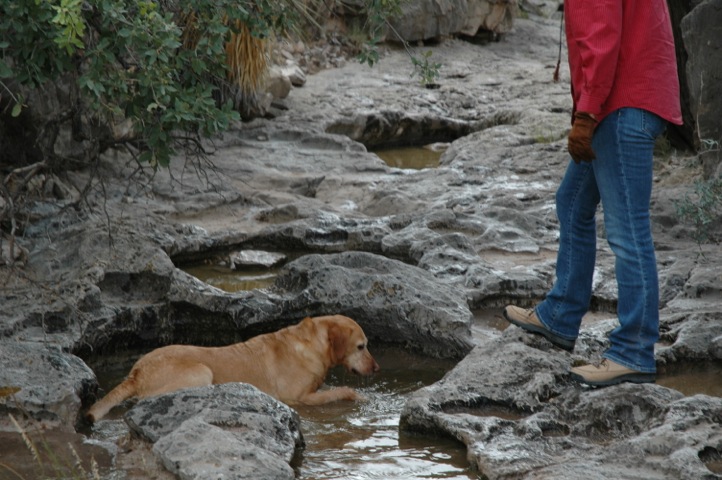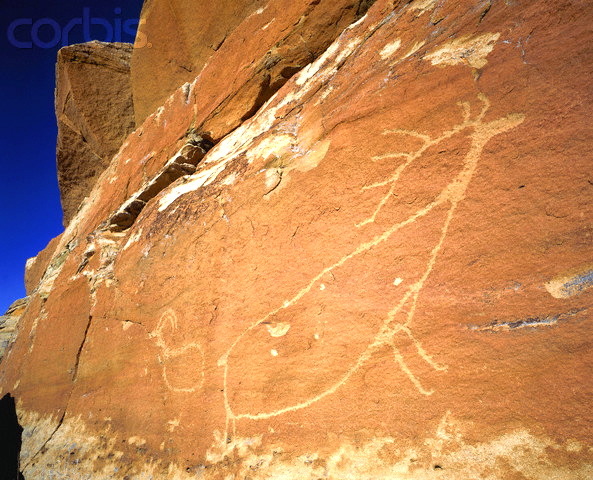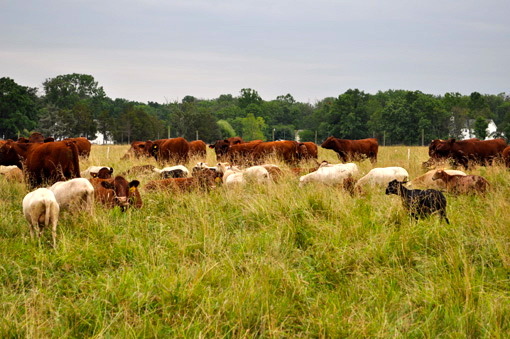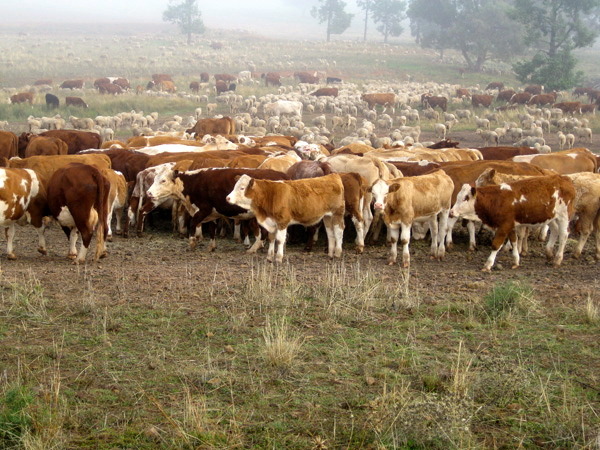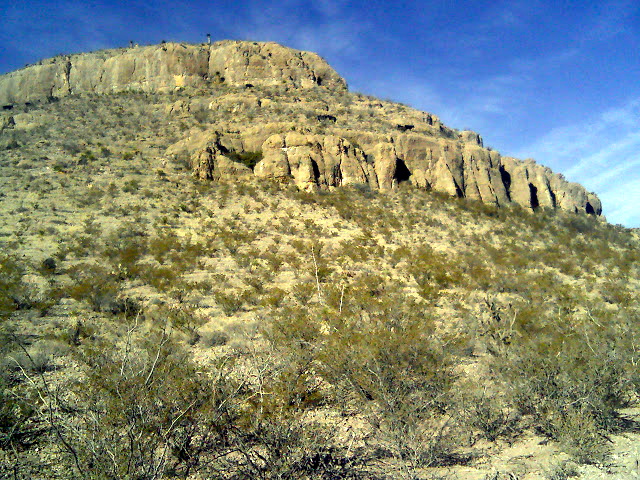Cows And Desert Bighorn Sheep
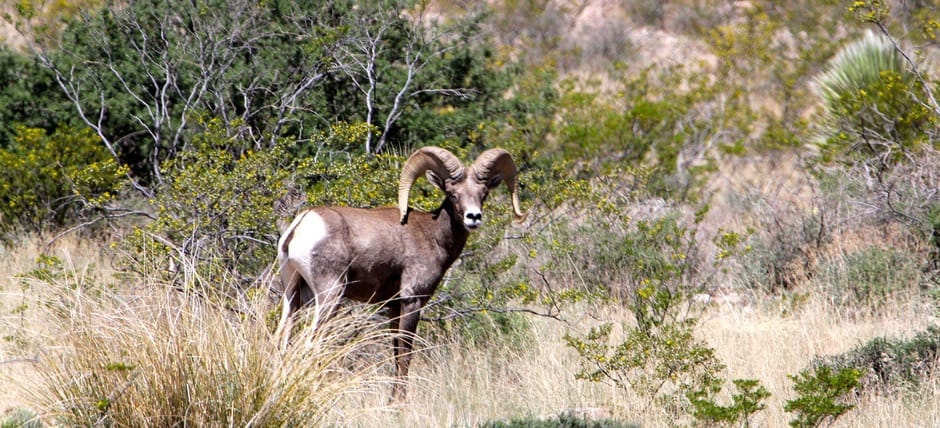
The desert bighorn sheep (Ovis canadensis nelsoni) is one of the four subspecies of desert bighorn sheep that occur in North America. The desert bighorn is named for the American naturalist, Edward William Nelson and is found in the desert Southwest and Northern Mexico.
Experts today say that prior to European settlement, there were 1.5 to 2-million bighorn of which about 7,000 were desert bighorn. However around 1604 early Spanish explorer, Don Juan de Oñate y Salazar, described desert bighorn skull piles at bighorn-hunting Indian villages which would indicate far-greater numbers, and that bighorn were out on grasslands.
Today desert bighorn are found in the high-desert mountains. Desert bighorn generally behave like all bighorn, with one exception: They can go for long times without free water. They are similar in size to mule deer. Rams weigh 115 – 280 pounds, ewes less. Bighorn have unique concave hooves which allow them to climb steep rocky terrain quickly. They use this ability and keen eyesight to avoid predators like lions, coyotes and bobcats.
Horns develop soon after birth and continue to grow throughout the animal’s life. Mature rams have enormous curling horns which measure over 3 feet long and can have more than 12 inches of circumference at the base. Ewes’ horns are smaller, lighter and straighter. At age 8 an adult ram may have 30 pounds of horns. Rams sometimes rub (“broom”) their horns to improve their field of view. Rams and ewes use their horns to break open cactus and to fight. Bighorn live 10 to 20 years. Desert bighorn are primarily browsers and weed (forb) eaters: mostly perennials. Like mule deer and antelope, when they can find tender, green succulent grass, they eat it; otherwise they are seeking out the higher nutrition provided by browse and weeds.
“The desert bighorn does well in the desert and can tolerate high body temperatures. In the heat of the day bighorn will rest in the shade of a tree, or caves.”
“Desert bighorn in far-West Texas are adapted to a desert mountain environment and can tolerate little or no permanent water although they do better where water is provided. Some bighorn can go weeks or months without water, processing water from their food and rain water that collects in small rock pools (tinajas).”
Without water, bighorn can lose 30% of their body weight. After they drink this is quickly recovered. This adaptive strategy has allowed bands of bighorn to survive in areas too dry for their predators.
“Desert bighorn sheep live in family units of around 10 individuals although sometimes herds will reach 100 in size.”
“Rams fight each other for the ewes during the rut but for the rest of the year rams and ewes live apart. The breeding season is usually July through October but specific weather conditions could trigger breeding at anytime. Lambs are born after 180 days usually in late winter.”
Bighorn in Texas were virtually wiped out by 1960. Today, after 50-years of restoration, the state population of desert bighorn is estimated at around 1,200 animals of which 400-500 are in the Sierra Diablos. We believe that at any given time we have about 100 sheep on Circle Ranch depending on season and rainfall.
“Desert bighorn sheep are the rarest of the four subspecies of bighorn sheep. Permits to hunt one are extremely valuable. All funds we receive from permit sales, and much more, is spent on our wildlife restoration efforts.”
“Our primary tools for our desert bighorn are permanent water, holistic planned grazing, and net-fence modifications to help sheep move around. Sheep managers say these cougar should be removed since they eat sheep. But, since predator eradications eventually backfire, we avoid them. Having lots and lots of water points reduces ambush potential.”
Circle Ranch has 170 permanent water points on 32,000 acres. Several dozen of these are in the high mountains above the escarpments used by sheep. Although sheep would be there without permanent water, we are able to maintain larger numbers and also elk, pronghorn, mule deer, aoudad, and periodically up to 1,000 cattle in the high country because of this water – our most important wildlife practice.
“Among the many wild and domestic species which Texas’ sheep managers intend to replace with more-valuable bighorn, the aoudad is a high priority. Allegedly aoudad drive bighorn off water, food, and disrupt breeding. We have both at Circle and have not seen this. To the contrary: The aoudad ewe shown above with two bighorn rams was one of seven aoudad grazing alongside bighorn in Little Wood Canyon on December 29, 2012. ‘Conflict’ within and between species is a fact. But, this notion that aoudad and bighorn cannot co-exist is another example of “What we ‘know’, that just ain’t so!” Let us use some pragmatism and common sense. Aoudad are here to stay: Despite $-millions spent on aoudad eradications they are increasing. They have economic (hunting) value to landowners; the public likes looking at them. They are a ‘buffer’ species, sparing bighorn from lion predation. They seem to us to fill an empty niche in our desert ecology, and can be a source of the much-needed animal impact without which we cannot restore habitat for all wild animals.”
“Texas’ sheep managers say native Texas elk also harm bighorn and plants. So, they are ‘lethally-removing’ all elk on state-managed lands in far-West Texas, and requiring private landowners to do this in exchange for receiving animals for bighorn reintroductions. Yet, for hundreds of millennia desert bighorn, elk and bison shared Western ranges along with other species including pronghorn, mule deer and their predators. We know those shared ranges were far-more productive back when lots of different animals were in them.”
Until Europeans hunted them out, bison were the primary large grazers on the plains and in the mountains. They were replaced with domestic cattle which are very similar in their animal impact and are manageable. While plants on Western ranges were often over-utilized, the land got animal impact. But over the last 30 years the ranges have been destocked as cattle have moved to feedlots. Without animal impact they are in decline. Sheep managers insist cows hurt sheep and sheep habitat. But are they correct?
Let’s look “down-under” for some answers. Quoting Quivera Coalition’s Courtney White, “In seven years Eric Harvey expanded plant species numbers on his farm in New South Wales from 7 to 136. He did this with a flerd, a co-mingled flock of sheep and a herd of cattle.
“To say that it is not traditional to run cattle and sheep together would be a big understatement. Not only do many in agriculture (and wildlife) consider the two incompatible from a grazing perspective, most sheep and cattle farmers are historically incompatible as well. In fact, Australia endured range wars between sheep men and stockmen much like America did in the 19th Century.”
To Eric, this situation represents a missed opportunity both ecologically and economically. Years ago he saw sheep and cattle grazing in a farm in Africa and thought, “That makes sense!” When Eric purchased Gilgai Farm (they don’t call them ranches in Australia) after a successful career as a wool trader, he knew right from the start that he wanted to run a flerd. The reason was simple: He needed to re-carbonize the land soil.
Poor stewardship of Gilgai over the years – mostly out of ignorance – had depleted the farm’s soils of essential elements especially carbon which is critical to microbial life and thus to plant life. Eric intended to reverse this. But where were the minerals going to come from? Trucks? A mine? A factory? A talk with a neighbor provided the answer: the sky. Carbon was freely available in the air; all he had to do was to get it into the soil via photosynthesis and planned grazing practices. Eric set out to try. In 2005 he put together his first flerd eventually raising totals to 5,000 sheep and 600 cows. His goal was to use the different grazing behaviors of sheep and cattle to benefit plant vigor diversity and density. Cattle will knock over tall, dry grass, for instance, while sheep graze close to the ground. As Eric described it, herbivory creates an organic “pulse” below the ground surface as roots grow and contract with grazing. This feeds carbon and other elements to hungry fungi, protozoa and nematodes, which in turn feed grass plants. The manure “pulse” helps too. In short order soil fertility returned to Gilgai. As an added bonus nothing had to come from a factory!”
“We have found that running cattle and sheep together has given us a powerful ecological tool for repair and rehabilitation. The livestock are grazed at a very high density for a very short period of time across 196 paddocks. Most paddocks are only grazed for one day and then rested 180 days. The effect is a tremendous pulse of organic matter in our soils each grazing, from plants as well as urine and manure. Having dung beetles “follow” the herd as soil renovators and aerators means paddocks get healthier with each grazing and organic carbon is increasing. Organic carbon holds 7 times its own weight in water so the cumulative effect of a continual increase in carbon is a massive continual increase in the water holding capacity of soil. The action of herd effect and animal impact are tools that we have used through our grazing system to repair and restore problem areas, e.g. scalded country and gully erosion.” ….Eric Harvey, Gilgai Farm, New South Wales
Likewise, back home at Circle Ranch, adding animal impact from winter-grazed cattle to that of free-ranging wild sheep, mule deer, elk. pronghorn and aoudad, has helped the cows, the bighorn sheep, and the plants both need.
“So why do folks claim cattle and sheep don’t mix? “It must be a paradigm thing with humans says Eric with a smile. It’s not an issue in Nature.”
In 2013, HMI is presenting a series of classes based on the use of cattle to help wildlife. Cows and Quail is the only wildlife and habitat class based on the recognition that plants need animals as much as animals need plants. To find a class near you: Go here for information.



